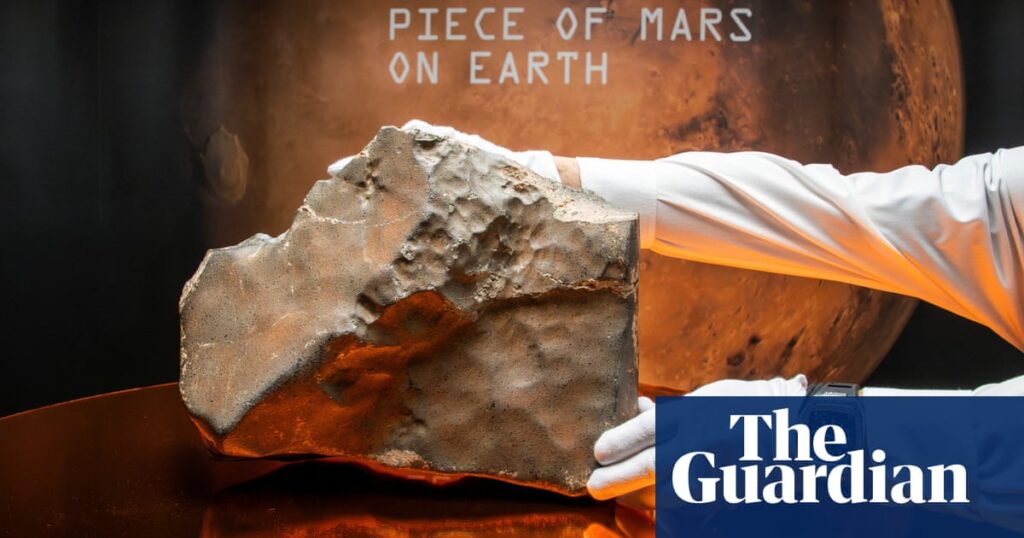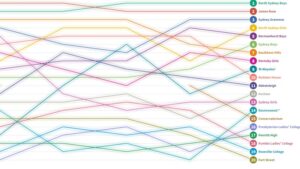
The largest piece of Mars ever discovered on Earth was sold for just over $5 million at a New York auction on Wednesday, marking a significant moment in the sale of rare geological and archaeological objects. Meanwhile, a juvenile dinosaur skeleton fetched more than $30 million, underscoring the high stakes and interest in such unique artifacts.
The Martian meteorite, known as NWA 16788, weighs 54 pounds (25 kg) and was unearthed in the Sahara Desert in Niger by a meteorite hunter in November 2023. According to Sotheby’s, the rock was ejected from Mars’ surface due to a massive asteroid impact, traveling approximately 140 million miles (225 million km) to reach Earth. The auction house had initially estimated the rock’s sale price at between $2 million and $4 million.
The buyer’s identity remains undisclosed, but the final bid was recorded at $4.3 million. Including various fees and costs, the official sale price reached approximately $5.3 million. The auction saw two advance bids of $1.9 million and $2 million, with live bidding proceeding more slowly than anticipated. To encourage more offers, the auctioneer reduced bid increments from $200,000-$300,000 to $100,000 after reaching the $4 million mark.
A Rare Martian Find
The meteorite is notable not only for its size but also for its rarity. Measuring nearly 15 inches by 11 inches by 6 inches (375 mm by 279 mm by 152 mm), it is about 70% larger than the next largest Martian rock found on Earth. According to Sotheby’s, it accounts for nearly 7% of all Martian material currently on our planet. Out of more than 77,000 officially recognized meteorites on Earth, only 400 are identified as Martian.
“This Martian meteorite is the largest piece of Mars we have ever found by a long shot,” said Cassandra Hatton, vice-chairman for science and natural history at Sotheby’s, in a pre-auction interview. “So it’s more than double the size of what we previously thought was the largest piece of Mars.”
Scientific Verification and Composition
While the exact timing of the meteorite’s departure from Mars is uncertain, testing suggests it occurred relatively recently. A specialized lab examined a small fragment of the meteorite, confirming its Martian origin by comparing its chemical composition to that of Martian meteorites identified by the Viking spacecraft in 1976.
The meteorite is classified as an “olivine-microgabbroic shergottite,” a type of rock formed from the slow cooling of Martian magma. It features a coarse-grained texture and contains minerals such as pyroxene and olivine. Its glassy surface likely resulted from the intense heat experienced during its passage through Earth’s atmosphere, Hatton explained. “So that was their first clue that this wasn’t just some big rock on the ground,” she added.
The Auction’s Other Highlights
In addition to the Martian meteorite, the auction featured a juvenile Ceratosaurus nasicornis dinosaur skeleton, which began with a high advance bid of $6 million. Bidding escalated in increments of $500,000 and later $1 million, ultimately concluding at $26 million. With fees and costs, the official sale price was $30.5 million, significantly exceeding the initial estimate of $4 million to $6 million.
The dinosaur skeleton, discovered in 1996 near Laramie, Wyoming, at the Bone Cabin Quarry, is more than 6 feet (2 meters) tall and nearly 11 feet long. Specialists assembled nearly 140 fossil bones, supplemented by sculpted materials, to recreate the skeleton, which is now ready for exhibition. The Ceratosaurus is believed to date back to the late Jurassic period, approximately 150 million years ago.
Ceratosaurus dinosaurs were bipedal with short arms, resembling the Tyrannosaurus rex but smaller in size. While Ceratosaurus could grow up to 25 feet long, the Tyrannosaurus rex could reach lengths of 40 feet. The skeleton was acquired last year by Fossilogic, a Utah-based fossil preparation and mounting company.
Implications and Future Prospects
Wednesday’s auction was part of Sotheby’s Geek Week 2025, featuring 122 items, including other meteorites, fossils, and gem-quality minerals. The sale of such rare and scientifically significant artifacts underscores the growing interest and investment in natural history collectibles.
As the market for rare geological and paleontological specimens continues to expand, experts anticipate further discoveries and auctions that could reshape our understanding of Earth’s history and the solar system. The sale of NWA 16788 not only highlights the allure of Martian rocks but also raises questions about the future of space exploration and the potential for more interplanetary artifacts to make their way to Earth.







